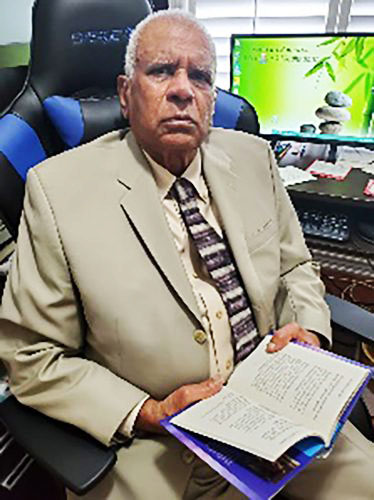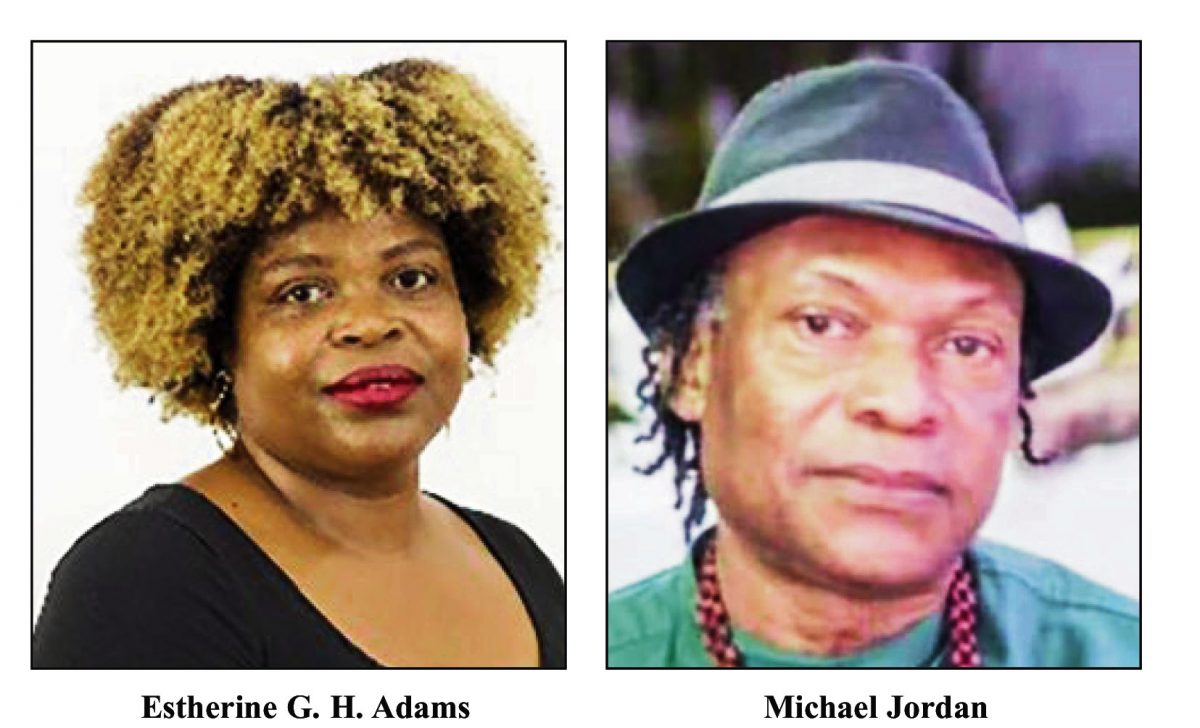 The Guyana Prize for Literature 2023 will be awarded on Friday March 1 in the dedicated Awards Presentation Ceremony at the National Cultural Centre at 7 pm. The Shortlists in all categories have been in public circulation for some time and has generated some amount of suspense and speculation about the identity of the winners. This will be revealed when the Chairman of the Jury for each Award reads the Judges’ Report at the Ceremony. This ceremony is one of several events in the Guyana Prize Literary Festival being held this week-end.
The Guyana Prize for Literature 2023 will be awarded on Friday March 1 in the dedicated Awards Presentation Ceremony at the National Cultural Centre at 7 pm. The Shortlists in all categories have been in public circulation for some time and has generated some amount of suspense and speculation about the identity of the winners. This will be revealed when the Chairman of the Jury for each Award reads the Judges’ Report at the Ceremony. This ceremony is one of several events in the Guyana Prize Literary Festival being held this week-end.
The 2023 Guyana Prize Winners will then receive prizes in Fiction, Poetry, Drama, Non-Fiction, First Book of Fiction, First Book of Poetry, and in the Guyana Prize Youth Awards in poetry and short story (for writers between 14 and 18). The tradition has been that the winners are honoured by receiving their prizes from the President of the Republic on whose behalf the Guyana Prize is awarded.
The Jurors each year are appointed from among outstanding writers, critics and literary figures from the field of culture and the arts. The 2023 Jurors are particularly distinguished and internationally acclaimed. They include a number of international prize winners among their numbers.
They are, for Non-Fiction: Prof Eddie Greene (Chair), Prof David Dabydeen, Dr Lisa Outar. Fiction: Prof Funso Aiyejina (Chair), Celeste Mohammed, Denise de Caires Narain Gurnah. Poetry: Prof Evelyn O’Callaghan (Chair), Prof Alison Donnell, Dr Richard Georges. Drama: Rawle Gibbons (Chair), Eugene Williams, Gem Madhoo-Nascimento. Youth Awards: Vanda Radzik (Chair), Camanie Khedaroo , Imam Baksh.
Below are the citations – what the judges had to say about the shortlisted writers.
NON-FICTION SHORTLIST:
(alphabetical order)
Estherine G. H. Adams, The Few Among the Many: Women’s Labour in British Guiana’s Jails, 1838-1917
The core argument of Adams’ book is that the prison in British Guiana in the period after Emancipation in 1838 was fundamentally a tool for controlling the labour of the non-white population of the colony. Adams shows how the labor of women inmates was particularly exploited in service of the plantation economy. Adams’ research is comprehensive and her book will be the main text on the subject of the incarceration of women in British Guiana, essential to all future researchers. It is both original and meticulously documented.
Daniella Chase, Becoming Bolder with Every Step
Daniella Chase’s memoir offers charming vignettes of childhood and family life in Bartica. Seen through the eyes of a child, Bartica is a place of peace and plenty, until early 2008, when gunmen rampaged through the town, slaughtering twelve innocent people. In the wake of these events and after graduating from the University of Guyana, Chase ends up teaching in Colombia, and her book offers a rare Guyanese glimpse into that country’s landscape and people. Writing with warmth, humour and liveliness, Chase reveals herself as a promising literary talent.

Joanne Collins-Gonsalves, Iris De Freitas Brazao: Legal Luminary and Trailblazer
This biography of Iris De Freitas is a most welcome record of an important figure in Caribbean women’s history. The result of more than a decade of archival work, Collins-Gonsalves reconstructs the life of the woman of African and Portuguese descent who in 1929 became the first woman to be called to the Bar in the Commonwealth Caribbean. Collins-Gonsalves is careful to weigh conditions regarding race as well as gender in each of the educational settings De Freitas braved in the early 20th century and offers insights along the way on the contributions of the Portuguese community to the Caribbean, the history of education in Guy ana from the time of slavery, and the evolution of tertiary and legal education in the region in the colonial and postcolonial eras.
Nesha Z. Haniff, The Pedagogy of Action: Small Axe Fall Big Tree
The Pedagogy of Action is what happens when a dedicated activist pauses in her unflagging work to write about her revolutionary thinking and teaching. The non-fiction form itself is revolutionized as Haniff defies the boundaries of memoir, pedagogical instruction, and expectations of the single voice. In this combination of intellectual biography, passionate description of a radical community-empowering HIV educational module, and a platform for student voices to embrace their own authority, Haniff’s book is an ode to teaching and to the thirst to be and see change in the world.
Earl B. John, Severance: Lives and Livelihoods 2016-2018
Severance: Lives and Livelihoods 2016-2018 comprises a collection of reports and commentaries mainly from newspapers that meticulously chronicle a significant series of industrial disputes which the author refers to as the “deconstruction of Guyana’s sugar industry.” Mr. John’s book is written with empathy, understanding, and knowledge of an industry he served for more than fifty years. As the foreword aptly states, “this book offers lessons to politicians, administrators and decision makers and will resonate and be relevant for years to come.”
Baytoram Ramharack, A Powerful Indian Voice, Alice Bhagwandai Singh: Reflections on her Work in Guyana
This is a fascinating story of Alice Bhagwandai Singh, an Indian woman who grew up in Suriname in the late 19th century before marrying and moving to Guyana with Jung Bahadur Singh, a medical doctor and legislator. She carved her name, independently of her husband, as a feminist, cultural activist, agent of change and writer, a combination of qualities that was a rarity for an Indian woman who lived in the immediate post-indenture period. Through the exemplary figure of Alice who earned a MBE in 1950, this book traces the relationship between ancestral India and diasporic Indian communities and its lasting impact on Guyana’s cultural heritage.
Daizal R. Samad and Ashwannie Harripersaud, A Dictionary of Guyanese Words and Expressions
This book is devoted to valorizing and tracing the rich contours of contemporary Guyanese creolese. The Dictionary’s pairing of creole words and expressions with accompanying sentences that demonstrate their usage in both local parlance and in standardized English offers a living landscape of Guyanese speech, one attentive to the contextual shifting that is ever present in linguistic deployments. The sample sentences also serve ultimately as illuminating snapshots of day-to-day Guyanese life and social encounters.
POETRY SHORTLIST
Best First Book of Poetry
Ruth Osman: All Made of Longing: The title foregrounds the theme of longing, particularly for freedom to rise above conformity to the norm of “proper” female conduct, that runs like a thread through these poems. As noted in the foreword, this is a woman’s voice, a woman engaged with the lifelong project of making and remaking herself.
We also welcomed the wry self-reflective examination of the writing process, and noted the haunting presence of a Caribbean history of suffering and fire. Osman is comfortable with local language and imagery (“the light/sterile as a reptile’s stare” 19), and even in her darker poems is not averse to a witty lightness of touch. All in all, this is a collection of accomplished and elegant works in a strong and controlled poetic voice.
Makeda Brathwaite: Go Fish: Go in the Pack
Again, the range of subjects covered in this arresting text range from sensual evocations of desire, love and lust to angry reflections on colonial history and contemporary political corruption (such as “Shame”) as well as the difficulties of a mixed-race heritage. Again, the writer cleverly alludes to the power of literature (“Books”) and draws on allusions to well-known modernist classics.
The poetry in this collection is drenched in careful observation of the ordinary as exceptional and sometimes brutal, rendering moments and encounters honestly in a language that is often gentle yet fierce. It is good to see the adept use of the range of Guyanese creole continuum in the work, although some poems may be a little challenging,
Best Overall Book of Poetry
Sasnarine Persaud: Mattress Makers
A prolific writer of books of fiction, poetry and essays, this collection is somewhat overlong. Nonetheless, it contains assured and adept poems about ancestral roots and religion and effectively spans landscapes from Kolkata to Georgetown, Toronto to Florida.
Persaud’s Mattress Makers displays a traveller’s voice at ease and moving comfortably across historic, spiritual, domestic, and pastoral registers. The poet’s sepia-tinged hymns create nostalgic portraits of a Guyana from a time before now: “why did we yearn / for evenings on Savis Dam” (“Canal No 2 Polder”). But the poet departs often, chronicling the diasporic experience through the Caribbean, North America, and elsewhere. India bleeds through it all, an ever present and effervescent touchstone for the writer’s lens and aesthetic.
Ian McDonald: Not Quite Without a Moon
Another late work by a poet still on top of his craft. The collection is moving and varied, a strong and well-rendered selection of writing. The poems are exquisite and poignant – piercing through time to cherished memories of his childhood and strong sense of belonging to Guyana (“Place of worship”, “Forest at Night”). There is something wondrous in the way McDonald manages to mine the mundane, the everyday and find glory in it.
Some of the simple portraits of ordinary Guyanese men and women (cricket fans and their commentaries, “Mrs Mathews” and her love of poetry, sugar workers in a rumshop discussing what they will use their bonuses to buy) evoke deep emotion in the reader, as do the matter-of-fact thoughts on aging and the defiant assertion of joy, friendships, beauty and above all, love.

FICTION SHORTLIST
BEST FIRST BOOK CATEGORY
NO SHORTLIST (citation for the honourable mention will be delivered alongside general judges’ observations at the award ceremony).
BEST BOOK CATEGORY
in alphabetical order by surname:
The Girl in the Pink Pleated Skirt by Michael Jordan
The first-person narrator of this novel is emotionally and mentally invested. He combines the art of investigative journalism with the skills of a passionate amateur detective to unravel the political and police corruption that had caused the official investigations of the horrific murders of young Guyanese girls to go cold. In having the courage and folly to follow the clues to their logical conclusion, the narrator fulfils his life-long promise to unmask the identity of the person behind the dastardly murder of the girl in the pink pleated skirt. The writing is confident, the dialogue is appropriately modulated to convey Guyanese urban culture, and the characters, both the incidental and central, come alive in the orchestrating hand of Michael Jordan.
Rage from the Backwaters by Somnauth Narine
A fire in New York sets in motion events which would lead the protagonist to undertake a revelatory trip back to the interior of Guyana to discover a historical fire in the memory vault of family secrets, among which is the identity of a cross-national arsonist. The trajectory of the novel is at once personal and communal, an exploration how a past can affect a present. It is a novel about atonement. It is not surprising, therefore, that the resolution forces many of the characters to re-assess their contemporary relationships. This novel is carefully modulated by the author’s wry sense of humour; its prose is competent and purposeful; and its narrative pacing is captivating.
Slippery Ochro by Kennard Ramphal
This is a story about the traditional smart man, an Anansi Trickster figure, who gets his comeuppance in the end. The narrative is anchored on the simplicity and generally trusting and sharing temperament of rural dwellers, the blend of eccentric and regular characters in villages, and their mostly uncomplicated inter-personal relationships. The strength of this novel resides in the author’s ability to convey the essence and subterranean complexity of village life with compassion and understanding.
DRAMA SHORTLIST
JAMAL LA ROSE, REQUIEM FOR THE LIVING
A domestic melodrama with lively, though sometimes inconsistent, dialogue, but interesting characters. The conflict between siblings in this story is based on property rights. As this drama progresses episodes of incest, cheating, lies and betrayals are exposed and, presumably, communicated as life’s lessons to the young boy in the family. The style resembles soap opera with action and language at times, excessive or simply unclear. Missing from the play also are the counter-balance of the ‘villain’s story and a revelatory ending.
SHAPHAN A. HESTICK : WITH A KISS
A credible and commendable attempt at reasoning through and providing an imaginative context for Judas’s betrayal of the Christ. The plot of this play places Judas’s story in the context of Roman political and civic oppression, his resistance to and eventual compromise with same. Other elements include ethnic, class and gender discrimination within Jewish society and the apolitical nature of the Jesus movement, which itself becomes a source of tension. The play successfully localizes its characters, making their language and action familiarly Guyanese, without violating biblical realism. At times, however, the action stutters into exposition and storytelling, rather than dramatic development. So too, is the play’s statement, encased as it is in an epilogue. Further, more use needs to be made of music before the work can describe itself as a ‘musical’.
HAROLD A. BASCOM: UNFOUNDED
A melodrama with an active plot that seeks to tackle issues of national concern. The plot is well-developed, the action engaging and characters interesting. The action of this play is set in the context of: a) rumors of an imminent invasion of the country by a hostile neighboring state; b) the experience of frequent electricity blackouts and c) historical ethnic divisions, particularly between Indians and Africans in the country. The play asks the question whether the crisis of invasion can bring about national unity?
In its approach to this question, we believe the play needs a better balance of responsibility between the races and to avoid the reinforcement of stereotypes. To its credit, however, the play shows the positive outcome and possibility of racial integration. The story signals hope in racial unity as consistent with the courage of personal choice. The action tells us, further, there is no hope for national unity or even personal evolution without enduring the pain of self-reckoning.
YOUTH AWARDS SHORTLIST
POETRY : BOYS
Samir Mohammed: Shadows In The Sand
GIRLS: (Listed in Alphabetical Order)
Reneka Anand: Lotus Flower Story; The Woman
Angel Moore: Yellow Cheese Pencil for a Vegan Artist (Untold Stories of An Artist)
Mya Sanders: Pitch Black
Italy Ton Chung: The Paradox of Youth
SHORT STORY
(listed in Alphabetical order)
BOYS:
Malachi Fyffe: Reinvention
Samir Mohammed: The Lighthouse at the Bottom of The Sea
GIRLS
Cianna Barkoye: February The Fifth
Kemilah Hodge: Plucking the Chrysanthemum









